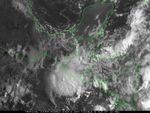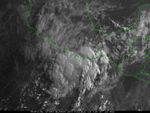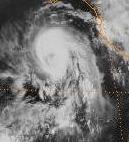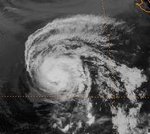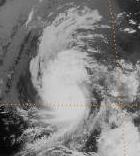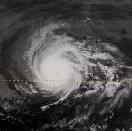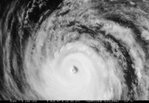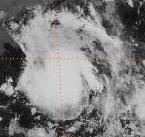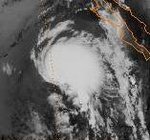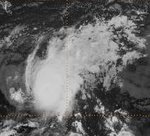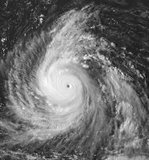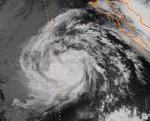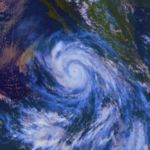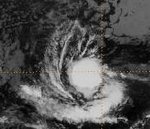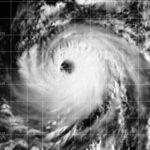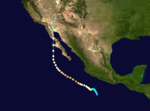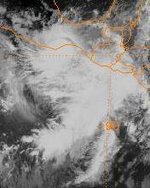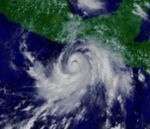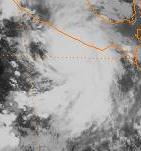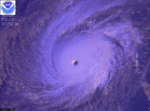1997 Pacific hurricane season
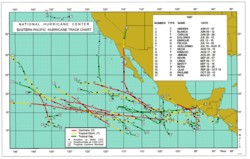
Season summary map |
| First storm formed: |
June 1, 1997 |
| Last storm dissipated: |
December 21, 1997 record |
| Strongest storm: |
Linda - 902 mbar (902 hpa) (record), 160 knots (300 km/h) (record) |
| Total storms: |
19 |
| Major storms ( Cat. 3+): |
7 |
| Total damage: |
>$7.6 billion (1997 USD)(record) |
| Total fatalities: |
234-404 direct |
|
|
Pacific hurricane seasons
1995, 1996, 1997, 1998, 1999 |
|
|
The 1997 Pacific hurricane season was an annual event in tropical cyclone meteorology. It was one of the most active seasons. With hundreds of deaths and billions of dollars in damage, this season the costliest and one of the deadliest Pacific hurricane seasons.
Hurricanes Linda, Pauline, and Nora were the most notable storms in 1997. Linda became the most intense east Pacific hurricane in recorded history. Hurricane Pauline killed several hundred people in Mexico due to heavy flooding, while Hurricane Nora caused flooding and damage in the Southwestern United States. In addition, Super Typhoons Oliwa and Paka originated in region before crossing the International Date Line and causing significant damage in the western Pacific.
Season summary
| Saffir-Simpson Hurricane Scale |
| TD |
TS |
1 |
2 |
3 |
4 |
5 |
The 1997 Pacific hurricane season officially started on May 15, 1997 in the eastern Pacific, and on June 1, 1997 in the central Pacific, and lasted until November 30, 1997. These dates conventionally delimit the period of each year when most tropical cyclones form in the northeastern Pacific Ocean. This season exceeded these boundaries appreciably, as Tropical Storm Paka formed December 2, and dissipated nineteen days later after moving into the Western Pacific.
The 1997 Pacific hurricane season was fairly active, due to the strong El Niño that was occurring at the time. El Niño causes wind shear to be reduced and water temperatures to increase, resulting in conditions more favourable for tropical cyclones in the East Pacific.
There were 24 cyclones in total, including five unnamed tropical depressions. Of these, 19 were in the east Pacific (east of 140° W). Of these, eight peaked at tropical storm intensity, while ten reached hurricane status. Seven of these reached Category 3 intensity or higher on the Saffir-Simpson hurricane scale, including Super Typhoons Oliwa and Paka, which became typhoons after crossing into the western Pacific.
Activity in the central Pacific was also above average. Two tropical storms formed, as did several tropical depressions. A number of storms moved in from the east. With a total of nine tropical cyclones entering or forming there, this was the fourth highest number since satellite observations began.
The first storm formed on June 1. The last storm dissipated December 21, which gives this season the latest known end. However, if December 6, the date the last storm crossed the dateline is taken to be the end, this season has the second latest end, behind the 1983 season and tied with 1957 season.
Storms
Tropical Storm Andres
|
|
|
|
| Duration |
June 2, 1997— June 7, 1997 |
| Intensity |
50 mph (85 km/h), 998 mbar ( hPa) |
Andres originated as a disturbance that had slowly organized formed into Tropical Depression One-E on June 1. The next day, it reached tropical storm status. After a brief period of a normal track to the northwest, Andres was picked up by westerly winds and became the first named storm to threaten Central America. Initially forecast to cross the isthmus and enter the Caribbean Sea, Andres instead turned to the southeast and paralleled the coast. This was the first time any East Pacific storm had taken such a path. Andres then turned back to the northeast. It weakened to a depression and made landfall near San Salvador on June 7 and dissipated shortly thereafter.
The only casualties were two fishermen who were reported missing. Power outages, flooding rivers, several car crashes, and damage to roughly ten homes was attributed to Andres. Damage was noted in parts of Nicaragua.
Tropical Storm Blanca
|
|
|
|
| Duration |
June 9, 1997— June 12, 1997 |
| Intensity |
45 mph (75 km/h), 1002 mbar ( hPa) |
Blanca was a short-lived tropical storm that briefly threatened land. Tropical Depression Two-E formed June 9 and strengthened into Tropical Storm Blanca six hours later. It moved northwest and briefly threatened land on June 10 as warnings and watches were established by the Meteorological Service of Mexico. Then, a ridge of high pressure turned Blanca away from the coast.
Despite moving over warm waters, a weakening trend unexpectly began, and Blanca was downgraded to a depression. and Blanca lost its circulation shortly after being downgraded on June 12.
Rains from Blanca were significant. There was no damage or casualties as Blanca's impact was generally minimal.
Tropical Storm Carlos
|
|
|
|
| Duration |
June 25, 1997— June 28, 1997 |
| Intensity |
50 mph (85 km/h), 996 mbar ( hPa) |
On June 25, a tropical wave that drifted in from the Atlantic became a tropical depression and that same day developed into Tropical Storm Carlos. As it moved west, Carlos encountered shearing winds and cooler waters and lost its tropical storm status after barely a day, and finally dissipated June 28. Except for Socorro Island, which the system passed close to, Carlos never threatened land.
Hurricane Dolores
|
|
|
|
| Duration |
July 6, 1997— July 12, 1997 |
| Intensity |
95 mph (150 km/h), 975 mbar ( hPa) |
Dolores began as Tropical Depression Six-E, forming late on July 5 and reaching tropical storm status the following day. Moving westward, Dolores strengthened into the first hurricane of the season on July 7. It reached a peak windspeed of 80 knots (150 km/h). Dolores then became the first hurricane in over two years to cross the 125° W meridian. The storm then started losing strength. Dolores dropped down to a depression on July 11 and dissipated late the next day after crossing into the Central Pacific Hurricane Centre's area of responsibility. The hurricane was not a threat to any land.
Hurricane Enrique
|
|
|
|
| Duration |
July 12, 1997— July 16, 1997 |
| Intensity |
115 mph (185 km/h), 960 mbar ( hPa) |
Enrique was the first major hurricane of the season. It originiated on July 12 when a tropical depression formed. It strengthened into a tropical storm twelve hours later, and became a hurricane on July 13. Enrique began fluctuating in intensity and reached its peak intensity of 100 knots (190 km/h) and 960 mbar (960 hPa) on July 14. Enrique then began to weaken, and dissipated over cooler waters on July 16. Enrique never threatened land.
Hurricane Felicia
|
|
|
|
| Duration |
July 14, 1997— July 22, 1997 |
| Intensity |
135 mph (215 km/h), 948 mbar ( hPa) |
Tropical Depression Eight-E, the storm that would become Felicia, formed south of the Mexican port of Manzanillo, Colima, on July 13. Its development was delayed by wind shear due to its proximity to Enrique. It became a tropical storm late July 15 as it moved west-northwestward. It became a hurricane July 17. Its development was again stalled by shear. After the shear let up, Felicia’s winds reached 115 knots (215 km/h) and its pressure fell to 948 mbar (948 hPa), making it the second major hurricane of the season. Felicia then began weakening. Shortly before being downgraded to a tropical storm, it crossed 140° W. Felicia was sheared and dissipated July 22, having never threatened land.
Hurricane Guillermo
|
|
|
|
| Duration |
July 30, 1997— August 24, 1997
(extratropical after August 15) |
| Intensity |
160 mph (260 km/h), 919 mbar ( hPa) |
A tropical wave that drifted across the shear-ridden Atlantic emerged into the Pacific Ocean on July 27. It organized into a depression July 30 and was named Tropical Storm Guillermo the next day. It quickly intensified, reaching hurricane status on August 1. Guillermo became a major hurricane August 2. It reached Category 4 intensity on August 3 before weakening slightly and restrengthening. The hurricane attained Category 5 strength August 4. Guillermo's peak intensity was 919 mbar (919 hPa) and 140 knots (260 km/h).
Guillermo then weakened slowly, becoming a tropical storm August 8. It crossed 140° W and entered the Central Pacific. It weakened to a depression late August 10 but restrengthened back into a storm 24 hours later when it encountered a small area of warm water. It weakened to a depression for the second and final time August 15 and lost tropical characteristics early the next day.
Guillermo's remnants recurved over the far northern Pacific. They were tracked to a point 500 nautical miles west of Vancouver Island. The remnants hung on for a few more days and drifted south before being absorbed by a mid-latitude cyclone August 24 off the coast of California.
Tropical Storm Hilda
|
|
|
|
| Duration |
August 10, 1997— August 15, 1997 |
| Intensity |
50 mph (85 km/h), 1000 mbar ( hPa) |
A tropical wave that had showed hints of development emerged into the East Pacific and organized into Tropical Depression Ten-E on August 10. Its development was inhibited by shear from a large mid-latitude cyclone. The depression managed to become a tropical storm late on August 11. Hilda was a tropical storm for less than three days. Shear weakened Hilda to a depression August 14 and destroyed the cyclone early on August 15. Hilda was no threat to land.
Tropical Storm Ignacio
|
|
Tropical Storm Ignacio |
TS |
|
|
|
| Duration |
August 17, 1997— August 20, 1997
(extratropical after August 19) |
| Intensity |
40 mph (65 km/h), 1005 mbar ( hPa) |
Tropical Storm Ignacio formed first as a depression in an area of disturbed weather on August 17. 12 hours later, it organized into a tropical storm. Ignacio's location of tropical cyclogenesis was further north and west of where most East Pacific tropical cyclones form. Steering currents pulled Ignacio north, where it encountered wind shear and cooler waters. Ignacio lost tropical characteristics August 19. The remnants moved north, bringing gusty winds to California coastal waters before dissipating. They were then absorbed by the same cyclone that absorbed the remnants of Hurricane Guillermo. It caused rainfall as far north as the U.S. state of Washington.
Hurricane Jimena
|
|
|
|
| Duration |
August 26, 1997— August 30, 1997 |
| Intensity |
140 mph (225 km/h), 942 mbar ( hPa) |
The next hurricane of the season, Jimena, had a very rapid intensification and an equally rapid decay. Tropical Depression Twelve-E formed August 25 from an area of disturbed weather in a rather easterly location. It became a tropical storm the next day and a hurricane on August 27. Intensification was rapid, with winds increasing from 65 to 115 knots (120 to 215 km/h) in the space of 12 to 15 hours.
It moved north-northwest. Jimena encountered an upper level trough. This caused very heavy wind shear which reduced its winds from 115 to 30 knots (215 to 60 km/h) in the space of a day. Jimena completely dissipated on August 30, not long after entering the Central Pacific. Hurricane Jimena was of no threat to land.
Super Typhoon Oliwa
|
|
|
|
| Duration |
September 3, 1997— September 17, 1997 |
| Intensity |
160 mph (260 km/h), 898 mbar ( hPa) |
Super Typhoon Oliwa began as a tropical disturbance that had meandered south of Johnston Atoll organized into Tropical Depression Two-C on September 2. Later that day, it was upgraded to Tropical Storm Oliwa ( Hawaiian for Oliver) as it slowly moved towards the west. It crossed the dateline late on September 3 and entered the Joint Typhoon Warning Centre's Area of Responsibility. In the Pacific Ocean, tropical cyclones are not renamed when they cross basin boundaries, so Oliwa kept its name.
Oliwa passed south of Wake on September 6, where it caused heavy rains but no damage. On September 7, Oliwa started a period of rapid strengthening, becoming a typhoon on September 8 and a Super Typhoon 8 hours later. Oliwa stayed at that intensity for over two days. While still a strong super typhoon, Oliwa passed near the Northern Marianas Islands. It then started weakening as it curved towards Japan. It made landfall as a minimal typhoon September 16. It quickly dissipated later that same day. Oliwa caused "damage and several fatalities" in Japan.
Tropical Storm Kevin
|
|
|
|
| Duration |
September 3, 1997— September 7, 1997 |
| Intensity |
60 mph (95 km/h), 994 mbar ( hPa) |
Tropical Storm Kevin, first displayed hints of development while crossing the Atlantic Ocean, and soon developed enough circulation to be a depression in the Pacific on September 3. It became a tropical storm on the morning of September 4. The environment was unfavourable, and two days later, Kevin weakened to a depression when deep convection ceased. It dissipated early on September 7, having never posed a threat to land.
Hurricane Linda
|
|
|
|
| Duration |
September 9, 1997— September 17, 1997 |
| Intensity |
185 mph (300 km/h) (record in E. Pacific),
902 mbar ( hPa) |
Hurricane Linda became the most powerful East Pacific hurricane ever observed when, on September 12, it reached a maximum windspeed of 160 knots (300 km/h) and a minimum pressure of 902 mbar (902 hPa).
Linda had no effect on any land, other than Socorro Island. However, early forecasts predicted that Linda would make landfall in California. The landfall never materialized, and Linda dissipated early September 18 while far out to sea. Warnings or watches were not necessary for any location.
Tropical Storm Marty
|
|
|
|
| Duration |
September 12, 1997— September 16, 1997 |
| Intensity |
45 mph (75 km/h), 1002 mbar ( hPa) |
Marty was a weak and short-lived tropical cyclone. Two tropical waves contributed to an area of disturbed weather that organized into Tropical Depression Fifteen-E late on September 12. Moving glacially in a westward direction, it strengthened into a tropical storm in the morning of September 14. Marty's forward speed slowed even more, and it turned to the south. It then encountered an unfavourable environment, and shear destroyed the cyclone late on September 16.
Hurricane Nora
|
|
|
|
| Duration |
September 16, 1997— September 26, 1997 |
| Intensity |
135 mph (215 km/h), 950 mbar ( hPa) |
Hurricane Nora was the first hurricane to bring gale-force winds to the Continental United States since Kathleen in 1976. A tropical wave organized into Tropical Depression Sixteen-E on September 16 quickly strengthened into a tropical storm. Nora eventually peaked at Category 4. It then encountered water temperature anomalies, and fluctuated in strength. Then, a trough pulled Nora northward and accelerated the storm. After weakening to a Category 1, Nora made landfall in northern Baja California and stayed a tropical storm as it entered the United States. It dissipated over Arizona, but its remnants kept going north.
Rains were heavy, and damage amounted to "several hundred million dollars" in the United States. Several hundred people were rendered homeless, and there was wind and flood damage in Arizona. Nora killed two people in Mexico, and several indirect deaths were reported in California.
Tropical Storm Olaf
|
|
|
|
| Duration |
September 26, 1997— October 12, 1997 |
| Intensity |
70 mph (110 km/h), 989 mbar ( hPa) |
Tropical Storm Olaf was a weak but persistent tropical storm that made two landfalls and took an erratic path. A tropical depression formed September 26, was upgraded a tropical storm at the next advisory. The cyclone immediately moved north. Instead of strengthening into a hurricane as forecast, Olaf unexpectedly weakened. On September 29, Olaf made landfall near Salina Cruz, Oaxaca.
Olaf dissipated, and its remnants reversed direction and moved far out to sea. During later reanalysis, Olaf was found to be a tropical depression during most of this time, but at the time was considered dissipated. Olaf's remnants reformed, and started moving southeast on October 5. Olaf then turned to the north, and on October 12 made a second landfall near Manzanillo, Colima, as a tropical depression. Olaf dissipated, and the remnants again moved out to sea where they did not regenerate.
Olaf resulted in some reports of damage and flooding in Mexico and Guatemala. Several people were reported missing. All of its damage was from its first landfall.
Hurricane Pauline
|
|
|
|
| Duration |
October 5, 1997— October 10, 1997 |
| Intensity |
135 mph (215 km/h), 948 mbar ( hPa) |
Tropical depression Eighteen-E formed October 5. In a favourable environment, the cyclone to rapidly intensified, reaching Category 4 intensity. After twice peaking at that intensity, interaction with land weakened Pauline to a Category 2 by the time it made landfall on October 9. It accelerated to the northwest, and passed over a mountainous region. The mountains disrupted Pauline's circulation, and squeezed the moisture from the hurricane. Pauline dissipated on October 10 while over Jalisco.
Hurricane Pauline was the deadliest storm of the season. Landslides and flooding caused by heavy rain caused tragic loss of life and left thousands homeless. Casualties were at least 230. The Red Cross reported that 400 deaths, but this was disputed by Mexican officials. Regardless, Pauline was Mexico's deadliest hurricane since 1976's Liza.
In addition, the hurricane caused $7.5 billion in damage (1997 USD).
Hurricane Rick
|
|
|
|
| Duration |
November 7, 1997— November 11, 1997 |
| Intensity |
100 mph (160 km/h), 973 mbar ( hPa) |
Hurricane Rick was the first November cyclogenesis since the 1991 season. A tropical wave acquired enough organization to be called a tropical depression on November 7. It moved north before a trough of low pressure turned it to the northeast. It was named on November 8, and was upgraded to a hurricane the next day. It reached its peak intensity of 80 knots (160 km/h) and 973 mbar (973 hPa) November 9. Rick made landfall in Oaxaca—the same area devastated by Hurricane Pauline one month earlier—and quickly weakened, dissipating early November 11.
The storm downed trees, washed out recently repaired roads and disrupted communications in some small population centers. No one was killed.
Rick is one of only seven known hurricanes to form in the Pacific Ocean east of the dateline in the month of November. The other ones are Nina, Ruby, Iwa, Winnie, 1991's Nora, and 2006's Sergio.
Super Typhoon Paka
|
|
|
|
| Duration |
December 2, 1997— December 22, 1997 |
| Intensity |
185 mph (297 km/h), 901 mbar ( hPa) |
Tropical Depression Five-C formed on December 2, two days after the season ended. It was the second December tropical depression east of the dateline; 1983's Hurricane Winnie was the only other one. The depression strengthed into Tropical Storm Paka ( Hawaiian for Pat) while west of Palmyra Atoll. The system began to move westward at a steady pace. As Paka moved westward, dry air and wind shear disrupted its development until it crossed the dateline on December 6.
After entering the Western Pacific, the cyclone encountered a more favorable environment, resulting in Paka's rapid intensification. It became a typhoon on December 10 and passed near Kwajalein with winds of 100 knots (190 km/h). It strengthened further, twice reaching Category 5 intensity. While a Category 4 storm, Paka passed close to Guam on December 17, causing "major damage". Afterwards, Paka encountered a hostile environment and completely dissipated by the evening of December 22.
Other storms
In addition to the named storms, there were also five tropical depressions that did not reach storm strength. Two of the depressions were in the eastern Pacific while three formed in the central Pacific. None of them threatened land.
Tropical Depression Three-E formed June 21. Moving rapidly westward, it never strengthened and dissipated early on June 24. Several days later, on June 29, Five-E formed at midday and erratically moved to the west. After slowing down greatly, the depression dissipated on July 4.
Tropical Depression One-C formed on July 26 from a disturbance that had been showing signs of development for three days. It moved west to southwest through an unfavorable environment. On the morning of July 27, it was destroyed by wind shear caused by an upper-level trough. Tropical Depression Three-C was formed when a tropical disturbance organized into a depression on October 6. It moved slowly moved westward without intensifying, and dissipated the next day. Nearly a month later, Tropical Depression Four-C formed at night on October 30 and in a similar location to where One-C formed. Moving westward, it weakened gradually when it encountered a large mass of dry air, and dissipated late on October 31.
Season statistics
Timeline

The season began with the formation of Tropical Depression One-E on June 1 and ended with the dissipation of Tropical Depression Paka on December 22. The season can alternatively be considered to end on December 6, the day Tropical Storm Paka crossed the international dateline. No named storms formed in May, three in June, four in July, four in August, five in September, one in October, and one in November. Very unusually, a tropical storm formed in December, after the season ended. The only other time this happened since the satellite era began was in 1983.
Accumulated Cyclone Energy
| Accumulated Cyclone Energy |
| Name |
ACE |
Name |
ACE |
| Guillermo |
37.0 (2.97) |
Olaf |
2.44 |
| Linda |
28.6 |
Andres |
2.39 |
| Nora |
23.4 |
Hilda |
1.74 |
| Felicia |
16.2 (0.665) |
Kevin |
1.56 |
| Jimena |
11.8 |
Blanca |
1.13 |
| Pauline |
11.3 |
Carlos |
0.970 |
| Dolores |
8.36 |
Marty |
0.858 |
| Enrique |
7.88 |
Oliwa |
(0.810) |
| Rick |
3.46 |
Ignacio |
0.378 |
| Paka |
(3.45) |
|
| Total: 160 (7.89) |
Accumulated Cyclone Energy is a measure of how active a hurricane season is. It is calculated by squaring the windspeed of a cyclone with at least tropical storm-force winds every six hours, summing the results, and dividing that total by 104. This explains why Hurricane Guillermo has a higher ACE than Linda. It was not as strong as that storm, but because it was above tropical storm force for a longer time, it reached a higher ACE level. As a tropical cyclone does not have gale-force winds until it becomes a tropical storm, tropical depressions are not included in these tables. For all storms, ACE is given to three significant figures. The ACE in the east Pacific proper (140°W to North America) is given; the ACE in the central Pacific (the international dateline to 140°W) is given in brackets.
The table includes the ACE for Oliwa and Paka only during those storm's time east of the dateline. Their ACE west of the dateline is part of the totals of the 1997 typhoon season.
The Nation Hurricane Centre uses ACE to rank hurricane seasons as above-normal, near-normal, and below-normal. It defines below-normal as having an ACE less than 95*104 kt2 kt2; It defines above normal as having an ACE above 150*104 kt2 along with the numbers of any two of the following above average: tropical storms (15), hurricanes (9), or major hurricanes (4); It defines near-normal as having an ACE between 100*104 kt2 and 150*104 kt2, or an ACE above 150*104 kt2 with fewer than two of the numbers of the following above average: tropical storms (15), hurricanes (9), or major hurricanes (4).
This season has a total of 17 tropical storms, 9 hurricanes, 7 major hurricanes. The total ACE of this season is 160*104 kt2 in the east Pacific proper. This qualifies this season as above-normal. As of the start of the 2006 season, it is the most recent above-normal season.
Impact
| Impact (summary) |
| Name |
Date of strike |
Location |
Deaths |
Cost |
| Andres |
June 7 |
Near San Salvador, El Salvador |
2 |
unknown |
| Blanca |
June 10 |
Puerto Angel |
0 |
minimal |
| Nora |
September 25 |
Punta Eugenia |
6-7 |
≥100 million (1997 USD) |
| September 25 |
SSE of San Fernando |
| Olaf |
September 29 |
near Salina Cruz |
several |
unknown |
| October 12 |
near Manzanillo |
| Pauline |
October 9 |
near Puerto Escondido |
230-400 |
7.5 billion (1997 USD) |
| Rick |
November 10 |
near Puerto Escondido |
0 |
unknown |
This table summarizes the death toll for selected cyclones. This table is restricted to storms that threatened land only. The colour behind the date and location of landfall indicates its strength at that landfall or near miss. This table excludes Socorro Island as watches and warnings are not issued for that location.
While east of the dateline, Oliwa and Paka had no impact on land. However, in the western Pacific, Oliwa passed close to Agrihan and made landfall at Category 1 strength in southern Japan. Paka never made landfall, but its southern eyewall passed over Guam while it was a Category 4. Both did significant damage, and Oliwa killed seven people. Overall, this season's death toll makes it the deadliest since 1982.
This season is also the costliest on record. The over 7.5 billion dollars of damage from Hurricane Pauline, along with the "several hundred million dollars" of damage from Hurricane Nora makes this by far the costliest, breaking the old record held by the 1992 season.
1997 storm names
The following names were used for named storms that formed in the eastern Pacific in 1997. The names not retired from this list were used again in the 2003 season. This is the same list used for the 1991 season except for Felicia, which replaced Fefa. A storm was named Felicia for the first time in 1997. Also, the name "Dolores" was misspelled "Delores" in the 1991 season, and in this and subsequent seasons, the typo was corrected. Names that were not assigned are marked in gray.
- Andres
- Blanca
- Carlos
- Dolores
- Enrique
- Felicia
- Guillermo
- Hilda
|
- Ignacio
- Jimena
- Kevin
- Linda
- Marty
- Nora
- Olaf
- Pauline
|
- Rick
- Sandra (unused)
- Terry (unused)
- Vivian (unused)
- Waldo (unused)
- Xina (unused)
- York (unused)
- Zelda (unused)
|
Two names from the Central Pacific list were also used during the 1997 season—Oliwa and Paka. This was the first usage for both names.
Retirement
The World Meteorological Organization retired one name in the spring of 1998: Pauline. It was replaced in the 2003 season by Patricia.


